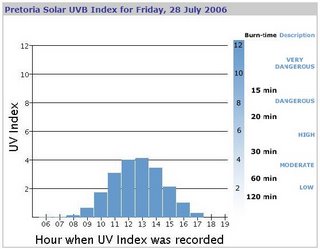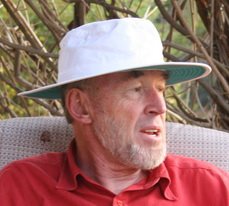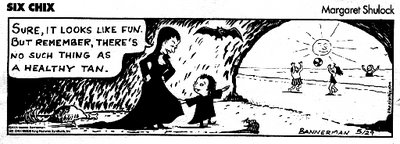Week 17 - Mad Dogs and Englishmen

In tropical climes there are certain times of day
When all the citizens retire,
to tear their clothes off and perspire.
It's one of those rules that the biggest fools obey,
Because the sun is much too sultry
and one must avoid its ultry-violet ray --
Papalaka-papalaka-papalaka-boo.
Digariga-digariga-digariga-doo.
The natives grieve when the white men leave their huts,
Because they're obviously, absolutely nuts
-Mad Dogs and Englishmen, Noel Coward (1932)
Here in the southern hemisphere we are passing through Winter. The weather is starting to warm up and signs of Spring are all around. This is the time of the year I start itching to get away in my 4x4. This is the best time of the year to visit those places which become unbearably hot later in the season. One problem with being in the great outdoors is increased exposure to the sun. Previously I did not worry much about it, but things have now changed… So, I have been looking at all the ways in which I can reduce my exposure to the sun.
Some facts on ultraviolet light
There is a wealth of information on ultraviolet radiation on the internet. Wikipedia is a good place to start if you would like more detail.
Ultraviolet radiation is radiation with a shorter wavelength than ordinary light. The ultraviolet spectrum covers a range of wavelengths, and is subdivided into UVA (longest wavelength), UVB (medium wavelength) and UVC (shorter wavelengths). Although the sun emits radiation over a very wide range, we are protected by the atmosphere, which absorbs the shorter wavelengths, so 99% of the UV radiation which reaches the earth’s surface is in the UVA range. This is fortunate as the shorter wavelengths have higher energy, and can have substantial effect on living organisms (Us!)
UVA is the least harmful, but can contribute to the aging of skin, DNA damage and possibly skin cancer. It penetrates deeply and does not cause sunburn. UVB light causes erythema – reddening of the skin (sunburn), and can cause skin cancer. This cancer connection is one reason for concern about ozone depletion and the ozone hole.
The body tans when exposed to moderate levels of radiation by releasing the brown pigment melanin. This helps to block UV penetration and prevent damage to the vulnerable skin tissues deeper down. Suntan lotion that partly blocks UV is widely available. The SPF rating describes the amount of protection given. This protection, however, applies only to UVB rays responsible for sunburn and not to UVA rays that penetrate more deeply into the skin.
Some sunscreen lotions include compounds such as titanium dioxide which helps protect against UVA rays. Other UVA blocking compounds found in sunscreen include zinc oxide and avobenzone.
Measuring ultraviolet radiation
 The sun emits radiation, and particles, over a very wide range. Various satellites are in place to monitor the behaviour of the sun. The most dangerous of this radiation consists of X-rays, but these do not reach the surface of the earth, being absorbed by the ozone layer. The amount of UV radiation reaching the ground varies widely, and depends on the angle of the sun, the thickness of the ozone layer, and the amount of water vapour and other particles (dust) in the atmosphere.
The sun emits radiation, and particles, over a very wide range. Various satellites are in place to monitor the behaviour of the sun. The most dangerous of this radiation consists of X-rays, but these do not reach the surface of the earth, being absorbed by the ozone layer. The amount of UV radiation reaching the ground varies widely, and depends on the angle of the sun, the thickness of the ozone layer, and the amount of water vapour and other particles (dust) in the atmosphere.The UV Index is a measure of how strong the UV radiation from the sun is at a particular place. The scale ranges from 0 (night-time) to 15 or 16. There is no qualitative difference between low and high UV levels: The only difference will be the rate at which your skin burns! It is recommended that people protect themselves when the UV index is 3 or higher.
Various services provide a prediction of the UV Index. In the US, the US Environmental Protection Agency provides useful information through the SunWise program. Closer to home, the South African Weather Service monitors the UV Index at various points around the country. The graph shows the measured UV Index for Pretoria, fairly close to where I live.

Wearing a hat
I had a nice hat with a broad brim, but somehow it got lost. So last week I bought a new one, and now keep it near my car keys, and take it with me whenever I might find myself out in the Sun.
Solar film for the SUV
I spend quite a lot of time in my car, and obviously when we are out touring we spend the whole day in the car. I was told that a good quality solar film will remove 97% or so of the ultraviolet light. The cost is very reasonable, so I had film installed on all the windows in my SUV, except the front windscreen, which I will think about for a while: The film introduces a certain amount of distortion, and this may not be clever on the windscreen.
 There are a few manufacturers of solar film, and they all say that their products will remove 97% or better of the ultraviolet light. However, there are some cheaper or “budget” films which may not be up to this standard.
There are a few manufacturers of solar film, and they all say that their products will remove 97% or better of the ultraviolet light. However, there are some cheaper or “budget” films which may not be up to this standard.The following information was found on the web:
Bekaert : http://www.solargard.com/index.cfm Tables show these films block 98% of UV light. “Window films block nearly 100% of ultraviolet light from passing through glass. The Panorama window films are approved products of the Skin Cancer Foundation.”
Toray Plastics: http://www.torayfilms.com/ Excell XT371 film: UV Protective degree (310-380 nm) – 99.2%.
So, what does this mean? Well, if the film blocks, for example, 98%, of the UV, this is equivalent to a reduction factor of 50. If the UV Index is 10, it would be effectively reduced to 10/50, ie: below 1. This is a substantial reduction!
Suntan lotions, sunscreen and sunblock
The objective is to protect your skin from the sun’s UV radiation. But just to confuse us, remember that there are suntan lotions which do the opposite, in order to tan more quickly!
There are many different formulations for sunscreens. The SPF (Sun Protection Factor) is a measure of the effectiveness of sunscreen, and works as a multiplier. For example, if you would normally develop sunburn after 30 minutes, then a sunscreen with an SPF of 10 would extend this time to 300 minutes, or 5 hours. You would still tan, but could stay much longer in the sun.
However, there are some other factors which may affect the effectiveness. For example, you need to make sure that sufficient sunscreen is used, and also that the sunscreen is properly applied to all exposed parts of the body. Also, it is important to ensure that the sunscreen is not removed, for example, by rubbing, or swimming, etc.
Now that I have done all this investigation, I collected together the various sunscreens we have around the house. These are:
Nivea Sun: SPF 20 – UVA+UVB protection plus vitamin E; main ingredient Ethylhexyl Methoxycinnamate
Elizabeth Anne’s Sun smart baby: SPF 40 – UVA+UVB protection with vitamin E and Aloe Vera; main ingredient Ethylhexyl Methoxycinnamate. Also contains Titanium Dioxide (UVA)
Dis-Chem SPF 30+ sunscreen: UVA + UVB protection; main ingredients Octyl Methoxycinnamate, Benzophenone 3 and Titanium Dioxide (UVA).
Here are some useful links if you are interested in further information:
US Environmental Protection Agency – SunWise program: http://www.epa.gov/sunwise/
Wikipedia: http://en.wikipedia.org/wiki/Ultraviolet and http://en.wikipedia.org/wiki/UV_index
US National Weather Service – Climate Prediction Center: Current UV Index forecast: http://www.cpc.ncep.noaa.gov/products/stratosphere/uv_index/uv_current.shtml
Today’s Space Weather, Space Environment Centre: http://sec.noaa.gov/today.html
SA Weather Service UVB Graphs: http://www.weathersa.co.za/UV/UV.jsp




